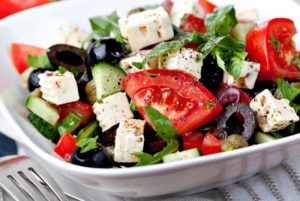Feta cheese is probably one of the world’s most loved Greek food product. However, more and more white cheeses are being labeled ‘feta’ even though they do not share the same texture, taste or nutritional value as the original. Are you another victim of false advertising?
Product specifications for feta cheese were officially set by the European Union (EU) back in 2002, when Greece obtained a protected designation of origin (PDO), meaning that producers of feta cheese outside of Greece are not allowed to market their products using the ‘feta’ name. This is not just some marketing ploy; it is important because if the cheese does not meet the criteria, it will not give you the health benefits you think you are paying for.
Feta, the national cheese of Greece, dates back to the eighth century B.C. and is produced with sheep’s milk in brine (cow’s milk can be added up to 30%) and aged for at least six months. The local flora used to feed sheep drastically impact its taste so the geographical region it originates from will impact its quality. In fact, product specifications for feta designate that its production be limited to the Greek regions of Macedonia, Thrace, Epirus, Thessalia, Mainland Greece, the Peloponnese peninsula and the island of Mytilini. Dodoni and Mt. Vikos produce excellent Greek feta that can be purchased through Amazon. Remember that you are purchasing the brine as well, so the actual quantity of cheese you receive might be a bit less than the product’s weight owing to the liquid contained within.

Unfortunately, the recent deal between the EU and Canada (the CETA) has made it even easier for companies to mislead you into buying low-quality cheese products since it does not include feta on the PDO list. Of course, besides steep international competition for feta production, there are other factors that play as well. For one, the industry has taken a serious hit because there is less demand in Greece for it. It is estimated that before the financial crisis 70% of Greeks consumed feta. They typically purchased it from markets one pound at a time. Today, there are fewer Greeks that can afford it, and those that can now usually purchase it at half a pound or less. Secondly, some restaurants in Greece have been caught serving lesser quality cheeses to tourists, leading them to believe that this is the original quality and taste. It makes sense then that when tourists go home, they buy something similar to what they consumed while traveling. Thirdly, the price of sheep’s milk is much more expensive than cow’s milk. So more and more companies are adding cow’s milk (up to the 30% maximum allowed) in order to reduce price. All in all, these circumstances leave consumers confused and easily-duped into buying low-quality foods.
There are now dozens of cheeses being labeled ‘fetta’ or using popular Greek names like “Odysseys” and “Athenos”. The Athenos company based in Wisconsin even goes so far as to falsely claim that it uses yiayias (the Greek word for grandmother) recipe, while its ads depict pictures of sunny Greek islands. The problem is that, like most American-made feta, it is made from 100% cow’s milk, which is set with specific cultures to bring out flavor. There are some artisan producers that use only goat’s milk, but they get it from the Saanan goat, a breed that produces large amounts of watered-down milk. This makes the cheese very sour and crumbly and lacks the nutty flavor and herbal undertones of cheese made from the Serrai sheep typically bred in Greece for milk.

Besides taste, there are so many health benefits to eating feta as opposed to other cheeses. It contains the protein alpha-lactalbumin, which has been shown to have antitumor properties; it is high in calcium, but does not cause acidosis in the body; it provides you with probiotics that keep your gut healthy and boost your immune system; it is a natural remedy for headaches and migraines; it lowers your risk of degenerative eye diseases; and it fights anemia. Just remember that it is high in sodium and saturated fat so go easy.
I confess that I adore mac-n-cheese. It was always my go-to comfort food. I have now replaced it with whole wheat spaghetti, drizzled with olive oil and generously sprinkled with feta cheese. I find it just as soothing and as an added bonus, my picky eating toddler loves it too! If cheese makes you smile, I bet real Greek feta will make you deliriously happy. It’s worth a try.
For more great nutrition information visit whatdetox.


















